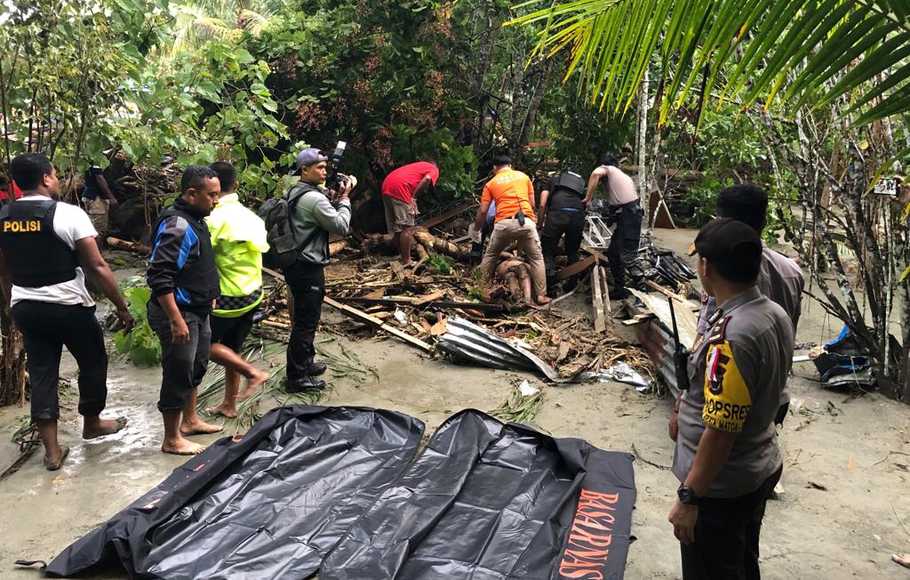Jayapura – Several regions of Jayapura City, Papua, were devastated by landslides and flash floods. According to the preliminary report, seven persons died as a result of landslides that struck numerous areas in Jayapura till Friday (6/1/2022) morning.
The landslide killed three individuals in the Nirwana area, two in the Bhayangkara region, and one in each of the APO Bengkel and Klofkam sectors, according to Deputy Head of Jayapura City Police AKBP Suprapto.
“The people who perished as a result of landslides have been taken to numerous hospitals in Jayapura City, including Bhayangkara Hospital,” Suprapto added.
He said that, in addition to claiming fatalities, the landslide wounded six persons and required medical attention.
Also Read : 12 Warga Jayapura Tertimbun Longsor, 4 Meninggal Dunia
Heavy rains that have lashed the Jayapura City region since Thursday (6/1/2022) night have produced floods and landslides in Papua Province’s capital city.
Meanwhile, Jayapura Deputy Mayor Rustan Saru stated that the water tragedy forced roughly 200 people in the Youtefa Market area to escape.
“Some of the people sought safety at the Maranatha Church,” he explained.
According to Rustan Saru, the water not only affected the Youtefa Market area, but also the Perumnas IV area, Organda Housing, SMAN 4 Entrop complex, CV Thomas complex, and Grand Abe Housing.
Victims of the Jayapura Flood
Meanwhile, Abdul Muhari, Acting Head of the BNPB Disaster Data, Information, and Communication Center, said his party had received reports of one citizen dying as a result of floods in numerous districts in Jayapura City.
“The Papua Regional Police Rapid Response Team has evacuated the casualty,” Abdul Muhari stated in a statement obtained by Beritasatu.com on Friday morning.
According to a report from Jayapura City’s Regional Disaster Management Agency (BPBD), heavy rain fell till 01.45 WIT on Thursday night, while light rain fell in Abepura District at 05.30 WIT on Friday morning.
“The municipal and provincial BPBD, TNI, Polri, Basarnas, RAPI, Orari, and TSBK teams are still on the ground in the impacted areas, carrying out emergency operations such as evacuating citizens. Flood-affected regions have been recorded in North Jayapura, South Jayapura, Abepura, Heram, and Muara Tami districts “Abdul Muhari said.
According to him, the Jayapura City BPBD used three rubber boats and one multi-purpose vehicle to evacuate citizens. “Based on observations in the field, the water level during the flood was roughly 150-200 centimeters, and local BPBD officials claimed that the puddle in the Yotefa Abepura Market area reached 300 centimeters,” he stated.
According to preliminary statistics as of today, Friday (7/1), around 03.30 WIB, one person died and a number of residents escaped to safer areas. To this day, the BPBD is still gathering data on impacted people and those who have left.
As a consequence of the tragedy, water damaged a number of public institutions, including the Aryoko Hospital, the Papua Governor’s Office, and a number of other public buildings and people’s homes.
“According to reports, electricity is still off in the affected region as of this morning,” Abdul Muhari stated.
According to Abdul Muhari, the Jayapura City BPBD also reported a landslide in the North Jayapura District. Because all employees are currently evacuating citizens stranded by flooding in the Abepura District, his party has yet to obtain comprehensive statistics.
According to the BMKG weather early warning, the Papua area today is at risk of heavy rain, which may be accompanied by lightning or thunder, as well as high gusts. Meanwhile, from dawn to night, the weather in Jayapura City was bright and gloomy.
Jayapura City is located in a region with a moderate to high flood risk. This possibility exists in three sub-districts, including regions now impacted by flooding.
The BNPB urged local governments and the general people to be on the lookout for possible aftershocks and other hydrometeorological dangers such as flash floods, landslides, and high winds. Meanwhile, the fundamental logistical demands of the impacted populations must be addressed and supplied concurrently.

